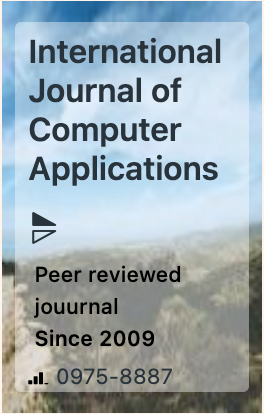The week's pick
Random Articles
Reseach Article
Harnessing Information Systems in Behavioral Operations Management: Managing Human Factors in Supply Chains
| International Journal of Computer Applications |
| Foundation of Computer Science (FCS), NY, USA |
| Volume 187 - Number 1 |
| Year of Publication: 2025 |
| Authors: Md Zahidur Rahman Farazi |
 10.5120/ijca2025924783
10.5120/ijca2025924783
|
Md Zahidur Rahman Farazi . Harnessing Information Systems in Behavioral Operations Management: Managing Human Factors in Supply Chains. International Journal of Computer Applications. 187, 1 ( May 2025), 46-56. DOI=10.5120/ijca2025924783
Abstract
This paper aims at investigating the contribution of human decision making towards the performance of the supply chain focusing on the Behavioral Operations Management perspective. Working with quantitative research methodology, the study investigates the impact of overconfidence and loss aversion over operational decisions in a firm using a Retailer Dataset and regression analysis. The analysis reveals that the Linear Regression model produces a mean squared error of 0.1337 and an R-squared value of 0.8569. In comparison, the Decision Tree Regression model achieves a mean squared error of 1.48 × 10⁻³¹ and an R-squared value of 1.0. The XGBoost Regression model yields a very low MSE of 1.17×10⁻⁸ and an R-squared value approaching 1. This evidence suggests that cognitive biases have dramatic effects on inventory and promotion policies, which cause suboptimal supply chain systems. Thus, the research establishes that behaviorally-updated versions of most supply chain operations management frameworks hold great potential to facilitate better decision making and aid increased supply chain performance. Future work should further extend these findings when creating particular examples of the application of these insights along with the machine learning tools to build the improved SCM models. Some of the solutions include awareness creation by furnishing decision-makers with training programs that improve their understanding of cognitive biases and the creation of conceptual tools for the resolution of such biases within the supply chain, with an aim of enhancing the efficiency of the supply chain systems.
References
- Q. Zhu and M. Kouhizadeh, “Blockchain Technology, Supply Chain Information, and Strategic Product Deletion Management,” IEEE Engineering Management Review, vol. 47, no. 1, pp. 36–44, Mar. 2019, doi: https://doi.org/10.1109/emr.2019.2898178.
- T. Somia, “Operations manager’s individual competencies for mass customization,” Depositolegale.it, Jul. 2024, doi: https://hdl.handle.net/20.500.14242/82544.
- T. Elbegzaya, “Application AI in Traditional Supply Chain Management Decision-Making,” dspace.unive.it, Jul. 2020, Available: http://dspace.unive.it/handle/10579/17733
- ]E. E. Foya, “Analysis and study Artificial Intelligence to improve Inventory management,” www.theseus.fi, 2021. https://www.theseus.fi/handle/10024/500648
- H.-T. Nguyen, “Global Supply Chain And Logistics Management,” 2019. Available: https://www.researchgate.net/profile/Hoang-Tien-Nguyen-2/publication/338570722_Global_Supply_Chain_And_Logistics_Management/links/62fccf10aa4b1206fab8f741/Global-Supply-Chain-And-Logistics-Management.pdf
- H. N. Perera, J. Hurley, B. Fahimnia, and M. Reisi, “The human factor in supply chain forecasting: A systematic review,” European Journal of Operational Research, vol. 274, no. 2, pp. 574–600, Apr. 2019, doi: https://doi.org/10.1016/j.ejor.2018.10.028.
- S. Haeussler, M. Stefan, M. Schneckenreither, and A. Onay, “The lead time updating trap: Analyzing human behavior in capacitated supply chains,” International Journal of Production Economics, vol. 234, p. 108034, Apr. 2021, doi: https://doi.org/10.1016/j.ijpe.2021.108034.
- L. M. Basson, P. J. Kilbourn, and J. Walters, “Forecast accuracy in demand planning: A fast-moving consumer goods case study,” Journal of Transport and Supply Chain Management, vol. 13, no. 1, Jun. 2019, doi: https://doi.org/10.4102/jtscm.v13i0.427.
- S. Lechler, A. Canzaniello, B. Roßmann, H. A. von der Gracht, and E. Hartmann, “Real-time data processing in supply chain management: revealing the uncertainty dilemma,” International Journal of Physical Distribution & Logistics Management, vol. 49, no. 10, pp. 1003–1019, Dec. 2019, doi: https://doi.org/10.1108/ijpdlm-12-2017-0398.
- X. Islami, “The relation between human resource management practices, supply chain management practices and competitive strategy as strategic instruments and their impact on organizational performance in manufacturing industry,” repository.ukim.mk, 2021. https://repository.ukim.mk/handle/20.500.12188/16201
- M. Keßler and Zahner, “The human factor in operations management -understanding the influence of cognitive biases in production and risk management.” Accessed: Oct. 06, 2024. [Online]. Available: https://publications.rwth-aachen.de/record/979943/files/979943.pdf#page=144
- Farazi, M. Z. R. (2024). “Evaluating the impact of AI and blockchain on credit risk mitigation: A predictive analytic approach using machine learning.” International Journal of Science and Research Archive, 13(1), 575–582. https://doi.org/10.30574/ijsra.2024.13.1.1707.
- R. Dehgani and N. Jafari Navimipour, “The impact of information technology and communication systems on the agility of supply chain management systems,” Kybernetes, vol. 48, no. 10, pp. 2217–2236, Nov. 2019, doi: https://doi.org/10.1108/k-10-2018-0532.
- P. P. Tallon, M. Queiroz, T. Coltman, and R. Sharma, “Information technology and the search for organizational agility: A systematic review with future research possibilities,” The Journal of Strategic Information Systems, vol. 28, no. 2, pp. 218–237, Jun. 2019, doi: https://doi.org/10.1016/j.jsis.2018.12.002.
- John Storm Pedersen and A. Wilkinson, Big data : promise, application and pitfalls. Edward Elgar Publishing, 2019.
- H. Benbya, T. H. Davenport, and S. Pachidi, “Artificial Intelligence in Organizations: Current State and Future Opportunities,” papers.ssrn.com, 2020. https://papers.ssrn.com/sol3/papers.cfm?abstract_id=3741983
- R. Hendijani, “Behavioral Operations Management: A Review of the Field,” Journal of Psychological Research, vol. 1, no. 3, Sep. 2019, doi: https://doi.org/10.30564/jpr.v1i3.736.
- W. V. den Brink, “Purchasing performance measurement through selecting and implementing key performance indicators,” essay.utwente.nl, Jul. 03, 2020. https://essay.utwente.nl/81939/
- S. Goudarzi, “Supply Chain Contracts: An Examination of Contract Performance through the Lens of Behavioural Factors,” the UWA Profiles and Research Repository, 2022, doi: https://doi.org/10.26182/yxvn-cm92.
- Farazi, M. Z. R. (2024). “Exploring the Role of Artificial Intelligence in Managing Emerging Risks: An In-Depth Study of AI Applications in Financial Institutions’ Risk Frameworks.” The American Journal of Management and Economics Innovations, 6(10), 20–40. https://doi.org/10.37547/tajmei/volume06issue10-04.
- Chalwe, Kalumba, Hellen, “Lived experiences of parents of children with autistic spectrum disorder in social interactions in selected schools of Lusaka district Zambia: a hermeneutic phenomenological approach.,” Unza.zm, 2022. https://dspace.unza.zm/handle/123456789/7732 (accessed Oct. 06, 2024).
- S. Tiwari, N. Kazemi, N. M. Modak, L. E. Cárdenas-Barrón, and S. Sarkar, “The effect of human errors on an integrated stochastic supply chain model with setup cost reduction and backorder price discount,” International Journal of Production Economics, vol. 226, p. 107643, Aug. 2020, doi: https://doi.org/10.1016/j.ijpe.2020.107643.
- Q. Li and G. Wu, “ERP System in the Logistics Information Management System of Supply Chain Enterprises,” Mobile Information Systems, vol. 2021, pp. 1–11, Oct. 2021, doi: https://doi.org/10.1155/2021/7423717.
- S. Gupta, V. A. Drave, S. Bag, and Z. Luo, “Leveraging Smart Supply Chain and Information System Agility for Supply Chain Flexibility,” Information Systems Frontiers, vol. 21, no. 3, pp. 547–564, Feb. 2019, doi: https://doi.org/10.1007/s10796-019-09901-5.
- OptimizeMRO, “Enterprise Resource Planning | Role in Improving Supply Chain Process,” OptimizeMRO, Aug. 11, 2022. https://www.optimizemro.com/blog/erp-and-its-role-in-improving-supply-chain-process/
- shipsy, “Shipsy - The World’s Leading Logistics Software Provider,” Shipsy, Nov. 15, 2022. https://shipsy.io/blogs/what-is-logistics-information-system/
- M. P. V. de Oliveira and R. Handfield, “Analytical foundations for development of real-time supply chain capabilities,” International Journal of Production Research, vol. 57, no. 5, pp. 1–19, Jul. 2018, doi: https://doi.org/10.1080/00207543.2018.1493240.
- Chowdhury, N. R. H., Masum, N. a. A., Farazi, M. Z. R., & Jahan, N. I. (2024). “The impact of predictive analytics on financial risk management in businesses.” World Journal of Advanced Research and Reviews, 23(3), 1378–1386. https://doi.org/10.30574/wjarr.2024.23.3.2807
- H. M. Badr and W. Ahmed, “A Comprehensive Analysis of Demand Prediction Models in Supply Chain Management,” American Journal of Industrial and Business Management, vol. 13, no. 12, pp. 1353–1376, Jan. 2023, doi: https://doi.org/10.4236/ajibm.2023.1312075.
- S. Yerpude and T. K. Singhal, “Digital customer order management enabled by the internet of things - an empirical validation,” International Journal of Public Sector Performance Management, vol. 9, no. 1/2, p. 71, 2022, doi: https://doi.org/10.1504/ijpspm.2022.119827.
- P. De Giovanni, “Smart Supply Chains with vendor managed inventory, coordination, and environmental performance,” European Journal of Operational Research, vol. 292, no. 2, Nov. 2020, doi: https://doi.org/10.1016/j.ejor.2020.10.049.
- Farazi, M. Z. R. (2024). “Designing circular supply chains with digital technologies for competitive sustainability: An operation management perspective.” International Journal of Science and Research Archive, 13(1), 2346–2359. https://doi.org/10.30574/ijsra.2024.13.1.1928.
- M. Kmiecik and H. Zangana, “Supporting of manufacturing system based on demand forecasting tool,” Logforum, vol. 18, no. 1, pp. 35–50, Mar. 2022, doi: https://doi.org/10.17270/j.log.2022.637.
- M. Wehbe, “Incorporating Machine Learning In RFID Inventory Management System To Optimize Logistics Operations,” Unideb.hu, May 21, 2024. https://dea.lib.unideb.hu/items/a46ba508-6001-41d0-924c-2daaab677c0d
- “Benefits of Using Machine Learning in Supply Chain,” Oodles ERP, Aug. 03, 2019. https://erpsolutions.oodles.io/blog/machine-learning-in-supply-chain/
- W.-C. Hu, H.-T. Wu, H.-H. Cho, and F.-H. Tseng, “Optimal Route Planning System for Logistics Vehicles Based on Artificial Intelligence 757 Optimal Route Planning System for Logistics Vehicles Based on Artificial Intelligence,” doi: https://doi.org/10.3966/160792642020052103013.
- Y. Feng, K. Lai, and Q. Zhu, “Green supply chain innovation: Emergence, adoption, and challenges,” International Journal of Production Economics, vol. 248, no. 1, p. 108497, Jun. 2022, doi: https://doi.org/10.1016/j.ijpe.2022.108497.
- R. Rathore and S. P. S. Rathore, “Machine Learning Applications in Human Resource Management: Predicting Employee Turnover and Performance,” International Journal for Global Academic & Scientific Research, vol. 3, no. 2, pp. 48–59, Jul. 2024, doi: https://doi.org/10.55938/ijgasr.v3i2.77.
- C. Kuzey, A. Uyar, and D. Delen, “An investigation of the factors influencing cost system functionality using decision trees, support vector machines and logistic regression,” International Journal of Accounting & Information Management, vol. 27, no. 1, pp. 27–55, Mar. 2019, doi: https://doi.org/10.1108/ijaim-04-2017-0052.
- R. Fildes, S. Ma, and S. Kolassa, “Retail forecasting: Research and Practice,” International Journal of Forecasting, vol. 38, no. 4, Dec. 2022, doi: https://doi.org/10.1016/j.ijforecast.2019.06.004. A. El Jaouhari, Z. Alhilali, J. Arif, S. Fellaki, M. Amejwal, and K. Azzouz, “Demand Forecasting Application with Regression and IoT Based Inventory Management System: A Case Study of a Semiconductor Manufacturing Company,” International Journal of Engineering Research in Africa, vol. 60, pp. 189–210, May 2022, doi: https://doi.org/10.4028/p-8ntq24.
- Farazi, M. Z. R. (2025). “Building Agile Supply Chains with Supply Chain 4.0: A Data-Driven Approach to Risk Management”The American Journal of Management and Economics Innovations, 6(10), 20–40. https://doi.org/10.37547/tajet/Volume07Issue03-03
- M. Pathak, “Artificial Intelligences in Supply Chain: Transforming Industries,” Bigscal - Software Development Company, Mar. 27, 2024. https://www.bigscal.com/blogs/logistics-industry/benefits-artificial-intelligence-supply-chain-logistic/
- M. M. Alasiri and A. A. Salameh, “The Impact of Business Intelligence (BI) and Decision Support Systems (DSS): Exploratory Study,” papers.ssrn.com, Jun. 20, 2020. https://papers.ssrn.com/sol3/papers.cfm?abstract_id=3631747
- Y. Zhan and K. H. Tan, “An analytic infrastructure for harvesting big data to enhance supply chain performance,” European Journal of Operational Research, vol. 281, no. 3, Sep. 2018, doi: https://doi.org/10.1016/j.ejor.2018.09.018.
- S. Kataria, “Driving Operational Excellence in Supply Chain Management with Power BI Insights,” Leading provider for Microsoft Azure Cloud Services & Power Platform Development | QServices, Jun. 20, 2024. https://www.qservicesit.com/driving-operational-excellence-in-supply-chain-management-with-power-bi-insights
- B. Adivar, I. Ö. Y. Hüseyinoğlu, and M. Christopher, “A quantitative performance management framework for assessing omnichannel retail supply chains,” Journal of Retailing and Consumer Services, vol. 48, no. 2, pp. 257–269, May 2019, doi: https://doi.org/10.1016/j.jretconser.2019.02.024.
- C. Aguilar-Palacios, S. Munoz-Romero, and J. L. Rojo-Alvarez, “Forecasting Promotional Sales Within the Neighbourhood,” IEEE Access, vol. 7, pp. 74759–74775, 2019, doi: https://doi.org/10.1109/access.2019.2920380.
- Farazi, M. Z. R. (2025). “Enhancing supply chain resilience with multi-agent systems and machine learning: a framework for adaptive decision-making”The American Journal of Management and Economics Innovations, 6(10), 20–40. https://doi.org/10.37547/tajet/Volume07Issue03-02
- M. F. Ibrahim, “Modeling technical decision-making for product development in engineering organizations UCL Discovery,” Ucl.ac.uk, Mar. 2024, doi: https://discovery.ucl.ac.uk/id/eprint/10188723/2/PhD%20Thesis%20-%20Fahmi%20Ibrahim.pdf.
- N. A. Akbar, A. Sunyoto, M. Rudyanto Arief, and W. Caesarendra, “Improvement of decision tree classifier accuracy for healthcare insurance fraud prediction by using Extreme Gradient Boosting algorithm,” 2020 International Conference on Informatics, Multimedia, Cyber and Information System (ICIMCIS), Nov. 2020, doi: https://doi.org/10.1109/icimcis51567.2020.9354286.
Index Terms
Keywords

